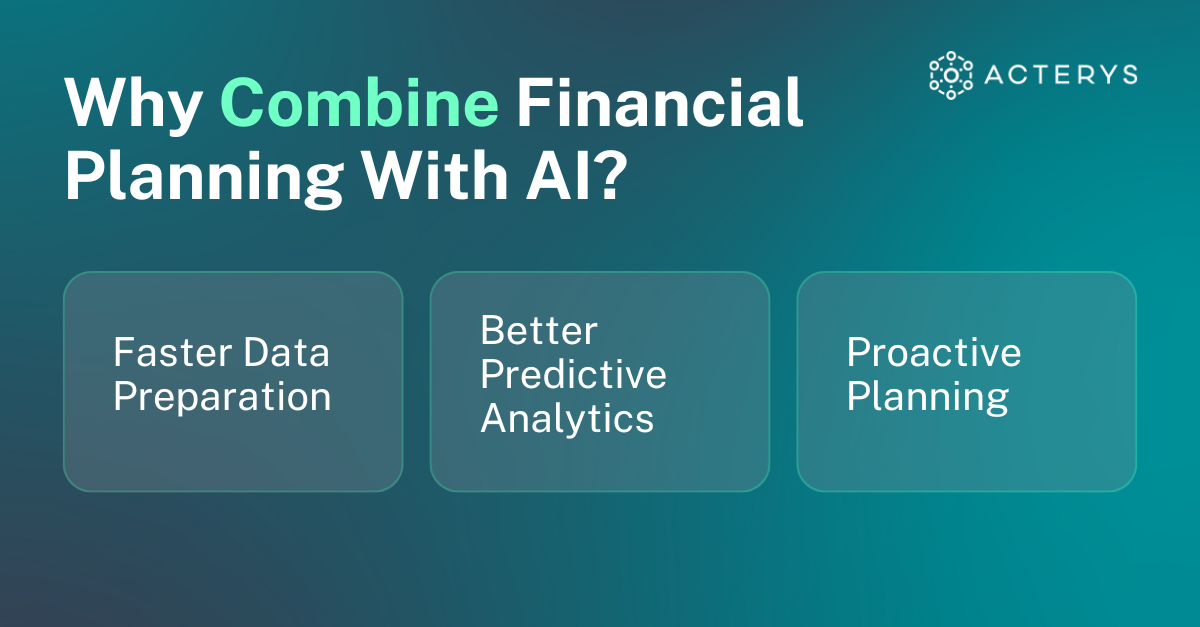
Table of Contents
Financial forecasting helps businesses predict future performance and set budgets, goals, and expectations, but these predictions are only as reliable as the forecasts. When you use AI for forecasting, you don’t just plan for the future; you can shape it.
Artificial intelligence (AI) brings a fresh perspective to financial forecasting by processing vast amounts of data to uncover new patterns and deeper insights. Businesses can transform their forecasting methods and realize a potent blend of speed, precision, and adaptability.
We already know that forecasting with AI improves accuracy. According to research from IBM, 50% of companies using AI for forecasting reduced overall error by at least 20%. Moreover, 25% of companies saw a decrease of at least 50%. The opportunity is there for finance teams to use AI and machine learning algorithms to unlock precision data analysis, make workflows smarter, and achieve unparalleled forecasting accuracy and insight.
Learn more about the benefits of using AI for financial planning, how to improve forecasting with AI, and how Acterys can help.
Why is AI Forecasting So Effective?
Even as businesses turn to AI for forecasting, they might have concerns about trust and reliability — or even how these tools work. AI-powered forecasting leverages advanced algorithms to sift through and analyze large data sets at unprecedented speeds. Beyond being quicker, AI-powered forecasting tools can also be more accurate and efficient for financial planning across industries. Examples include simplified strategic planning for government contractors, improved financial risk management in banking, and optimized demand forecasting in the retail sector.
However, AI systems are only as effective as the data they can access. In environments with poor data management practices or fragmented information, AI will produce less reliable forecasts. Before applying AI, businesses need to establish strong data management systems and consolidate all relevant data into an accessible single source of truth. Doing so gives AI tools the full context needed to generate actionable and accurate forecasts.
Keep in mind that AI systems can improve over time, as they adjust their predictions based on new data and outcomes. Nevertheless, maintaining a robust, integrated data infrastructure is key to leveraging the full potential of AI in forecasting.
Why Combine Financial Planning With AI?
The potential of AI for financial planning is that your business gains efficiency, accuracy, and foresight. Here are three benefits of using AI forecasting models in planning processes.
Faster Data Preparation
Traditional financial planning was labor-intensive, especially in data preparation, which could take weeks even for basic reports. AI and business intelligence tools like Power BI and Tableau have automated and accelerated data preparation so businesses can focus on more complex and impactful analyses.
Faster preparation doesn’t mean more errors, either. AI tools can automate routine calculations and data entry tasks, improving accuracy and consistency.
Better Predictive Analytics
Financial planning with AI unlocks new capabilities in predictive analytics, particularly when using techniques like time-series forecasting. Traditional forecasting can examine data from the past few years to predict short-term financial trends. AI predictive models go further by analyzing the impact of variable factors like marketing campaigns or market changes that might not show immediate effects.
For instance, a marketing campaign launched in January might not show its full impact until March or even later. Traditional methods struggle to link these events effectively. AI, however, can reveal insights into how actions taken today affect financial outcomes months later. This capability improves strategic planning and helps businesses react dynamically to market conditions.
Proactive Planning
AI also shifts financial planning from a reactive to a proactive stance. Instead of a fixed process with arbitrary goal-setting, planning becomes a continuous, informed process that adjusts to new data and insights as they become available. This makes forecasting more accurate than traditional budgeting, which often fails to account for unforeseen changes.
AI can recognize patterns that may not be immediately apparent, allowing businesses to differentiate between anomalies and lasting trends. This guided pattern recognition is crucial for planning that’s forward-facing instead of trying to catch up to yesterday’s events and trendlines.

How to Improve Forecasting With AI
AI can create forecasts from a variety of data sources, starting with internal metrics such as sales performance, production rates, and inventory levels. It can also consider external factors such as regulatory changes, consumer shifts, and weather conditions. Here are four steps for leveraging AI to upgrade your forecasting methods.
Integrate Competitive Benchmarking
Use AI to systematically gather and analyze benchmark competitor data to see where your business stands and where you can catch up or surpass the industry.
AI can analyze key performance indicators such as net profit margin, operational efficiencies, and competitor market share — generating strategic insights with greater speed than previously possible.
Adopt Dynamic Pricing Strategies
Use AI for demand forecasting to perform sensitivity analyses on pricing scenarios. AI helps predict how changes in pricing affect customer demand and behavior, enabling you to find the optimal balance between profitability and market share.
For example, AI can analyze past pricing adjustments and correlate them with changes in sales volume, considering external factors such as new products or changes in consumer purchasing power. This type of analysis allows for dynamic pricing strategies that adapt to market realities and anticipate customer responses.
Establish Feedback Loops
Choose AI systems that offer bi-directional data interactions for analyzing incoming data and responding in real time. This capability transforms forecasting from a predictive tool into a decision-making engine that keeps your business agile.
Platforms like Acterys can improve this capability by enabling direct interaction with analytics tools, such as pushing updates and changes through familiar interfaces. For example, a finance manager using AI for sales forecasting can generate and share detailed reports with the sales team through integrated platforms like Power BI and Excel. After reviewing the forecasts, the sales team can provide real-time feedback within the same platform. They might share trends they’ve observed in the field or suggest adjustments based on customer interactions.
Use Advanced Scenario Planning
While businesses have long practiced scenario planning, AI allows for faster, more intensive, and more realistic planning. AI tools help simulate many business outcomes based on different strategies and external conditions. This helps in visualizing potential impacts before they occur, allowing for better preparedness and strategic alignment.
For example, a multinational retail company looking to enter new markets can use AI models to simulate how store openings in different regions will affect business results. These models can account for numerous variables, including local economic conditions, consumer spending power, competitive presence, and socio-political factors — anything that could reasonably impact demand planning.
AI can also model outcomes based on different entry strategies, such as franchising versus corporate-owned stores, or online versus brick-and-mortar. It can also account for supply chain disruptions, currency fluctuations, and changes in trade policies.
How Does Acterys Improve AI Forecasting?
Acterys helps you bring your data to life by harnessing AI technology designed to improve financial forecasting, planning, and analysis. You can unite your business data with the tools you’re already familiar with, such as Power BI and Excel.
Here are three areas where Acterys improves AI forecasting.
Data Augmentation
Data augmentation is crucial for creating a complete and accurate dataset for forecasting, reporting, and extended planning and analysis (xP&A). In a globalized business environment, discrepancies can arise because companies have different enterprise resource planning (ERP) systems across regions, such as Microsoft Dynamics 365 in one region and SAP ERP in another. Customer and product names may also vary across different systems, such as CRM or marketing applications.
Acterys tackles these challenges by automatically harmonizing this diverse data. The system intelligently identifies and aligns discrepancies, such as recognizing “Mike” and “Michael” as the same individual or “six-pack” and “box” as the same product quantity type. This automation extends beyond data cleaning to encompass detailed information from sources including directories and social media.
Acterys can also help enrich contact data, which is crucial for processes such as account receivables. This improved data augmentation ensures that financial teams spend less time resolving data inaccuracies and more time on strategic analysis.
Data Insights
The next step is extracting meaningful insights from this refined data. Traditional business intelligence tools often fall short, presenting either too much obvious information or overwhelming users with irrelevant data. Acterys solves this by integrating domain-specific knowledge into the AI, which refines the data processing to produce meaningful, actionable insights.
Acterys’s approach to data insights involves identifying significant patterns and anomalies that inform strategic business decisions. This capability helps teams understand current financial conditions and predict trends and impacts, such as the delayed effects of marketing campaigns on revenue. Furthermore, Acterys-generated insights are tailored to your business’ specific needs and challenges.
Knowledge-Based Planning
The third pillar of Acterys’ AI is knowledge-based planning, which extends into critical areas such as transaction reclassification. This process involves automated actions, such as matching bank transactions with entries in the general ledger, that can be complicated by inconsistencies between transaction systems and accounting records.
Acterys streamlines the reconciliation process and enables the AI to learn from user inputs to improve its accuracy over time. For example, the AI can learn to recognize which transactions are regular and which are outliers, helping to prevent errors before they reach auditors.

Unlock the Power of AI for Forecasting
AI for forecasting is transforming how businesses recognize, anticipate, and react to financial challenges and opportunities. By streamlining financial planning and adding AI-powered insights, your team can proactively shape forecasting and strategy for better business outcomes.
Acterys improves AI forecasting by simplifying complex data processes and delivering actionable insights tailored to your business needs. The Acterys AI engine is designed to empower users to create their own algorithms for a myriad of tasks, from data preparation to predictive analytics. This open-ended approach ensures that as your business evolves, so too can your solutions within Acterys 24.1.
With seamless integration to platforms like Power BI and Excel, you can empower your team to make data-driven decisions with user-friendly tools that don’t require specialized expertise. Discover how Acterys can transform your data into a strategic asset and empower your business to forecast with greater precision and foresight. Sign up for a free trial.



